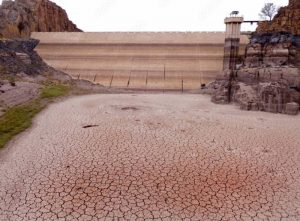Pakistan is predicted to be on the top ten list of countries battling water scarcity, according to Munir Akram, Pakistan’s Permanent Representative to the United Nations (UN). Water supplies in the country were at their lowest level in five years as of April 2022, with the two major dams, Tarbela and Mangla, at a dead level since February.
On February 22, 2022, the Tarbela Dam reached the dead level, while the Mangla Dam reached less than 1 percent of its ultimate capacity. According to the Pakistan Metrological Department, the water situation is deteriorating, and a drought-like condition may develop in several areas of Balochistan and upper Sindh in the coming days. Summer’s early arrival has already aggravated the problem, while climate change is reducing water supplies from catchment regions.
Water scarcity is a scary scenario that Pakistan is currently experiencing
The country is ranked 14th of the world’s 17 “very high-water-risk” countries. Pakistan has transitioned from a water-rich to a water-stressed country in the previous several decades, going from over 6000 cubic meters per capita in 1960 to 1017 cubic meters per capita in 2021.
One of the causes of Pakistan’s water problems is the country’s rapid population growth. This not only puts enormous strain on the limited water resources available, but it also has implications for food security. Inadequate water storage is another cause of water scarcity in Pakistan, which resulted in the loss of more than 120 BCM (billion cubic meters) of water during the floods of 2010, 2012, and 2014. The biggest water reservoirs’ current storage capacity is only 9% of total average flow, but the global average storage capacity is 40%. Currently, 97 percent of Pakistan’s fresh water is used in agriculture, which accounts for 18 percent of the country’s GDP. Water resources are being depleted due to inefficient agricultural practices, flood irrigation, a lack of hybrid seeding, and inadequate water management.
Water management challenges include a lack of basin-level water resource management and a robust method to prevent evaporation and pilferage. The deterioration of water infrastructure contributes to a large amount of water waste. With an overall efficiency of 39 percent, the country’s irrigation system is one of the least efficient in the world, owing to ageing and poor maintenance. Pakistan is also on the list of the world’s ten most susceptible countries to climate change. Changes in monsoon patterns, melting glaciers, rising temperatures, and the recurrence of floods and droughts show that the country is already confronting climate-related challenges to its water resources.

In recent years, Pakistan has experienced a number of floods as well as long periods of drought. The Indus River Basin, Pakistan’s main water source, is especially vulnerable to climate change due to its reliance on glacial and snow-melt and precipitation. In Sindh Province, where a big number of farmers have fled to urban areas due to a lack of water, it has already shrunk into a canal. Given that snow and ice melt runoff now account for 50 to 80 percent of typical water flows in the Indus River basin, this will cause landslides, catastrophic flooding, dam breaks, and soil erosion in the short term, as well as drought and hunger in the long run.
Water pollution is another huge issue in the country, with over half of the two million tons of human excrement annually polluting water. According to a study, 60 million people in Pakistan are at risk of being exposed to high levels of arsenic in groundwater on the Indus Plain. In Pakistan, water-borne infections are a primary source of mortality and misery. In Pakistan, around 60% of the population is affected by one or more of the major diseases linked to a lack of safe drinking water and better sanitation. They occupy around one-third of hospital beds and are responsible for almost 40% of all premature deaths in the country.
The whole political leadership, as well as all relevant stakeholders, must accept responsibility for Pakistan’s water crisis and express their intent to address it. The government must implement a massive paradigm shift that encourages water conservation. Water infrastructure upkeep, water conservation technologies, and public awareness will all be part of this. Pakistan’s water governance has to be reevaluated and made more compatible with other government programmers.
Pakistan created its first-ever National Water Policy in 2018
For the first time, it admits that water is a finite resource and that Pakistan must at the very least recoup the expenditures of its irrigation system. The strategy also considers the potential effects of climate change on water, discusses water prices, and emphasizes the importance of regional collaboration. However, it pays insufficient attention to water-sensitive urban designs, natural-hazard risk management, and trading in water-intensive crops. Any policy addressing these issues should include tailored, site-specific solutions that take into account the topography, source water body, receiving water body, and socioeconomic context of the environment.
To reduce and manage the over-extraction of groundwater, a regulatory framework for the installation and operation of tube wells should be developed and strictly enforced. For water recycling, methods and techniques for the use of drainage water and wastewater treatment should be created. Most significantly, a major social awareness campaign should be undertaken across the country to educate the general public about the critical problem of water scarcity in Pakistan, as most water-related problems are caused by illiteracy and a lack of understanding among the population. The water crisis in Pakistan can be controlled if the essential steps are implemented in a timely manner, and this can only be done with a strong commitment from all stakeholders, including policymakers and water consumers.







